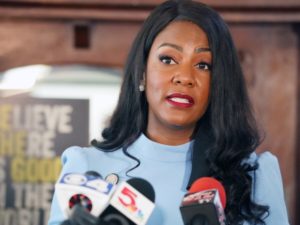A close look at North Minneapolis tells us more — but not enough — about child gun deaths.
The Trace is the nation’s only newsroom dedicated to covering gun violence full-time. Sign up for our newsletters to stay informed.
In August 2022, I arrived in Minneapolis on a reporting trip. The murder of George Floyd and the resulting chaos still hung in the air like acrid smoke. I sat in a lofty food court in a desolate downtown mall, and hurriedly prepared for an interview, the picture of the city’s gun violence problem coming into focus on my phone as I searched the internet. As it had in most places, gun purchasing in the state had surged during the pandemic. So had homicides, 80 percent of which took place within the metro area. I was there to report on a suicide, and learned that statewide they were twice as common outside the Twin Cities as within.
Despite making up less than 18 percent of the city’s population, Black people were disproportionately represented among shooting victims in Minneapolis, accounting for 83 percent in 2021 and 2022. One of every 150 Black residents was a victim of a shooting during those two years, compared to one in 3,769 white residents.
My impromptu search billowed out further with each impulsive tap of my thumb. The history of redlining had relegated masses of Black people into under-resourced neighborhoods, where — about 20 minutes north of where I sat — children were being randomly shot, killed, and buried with impunity.
In the spring of 2021, while America was trying to clear the racist air, three children in North Minneapolis were shot in the head by stray bullets within a month. I ended up writing a story about that community, and the man at its center, which is unique in many ways. But in cities across America, children are frequently caught in the crossfire and killed.
In Detroit, evidence suggests that an increase in drive-by shootings contributed to a 50 percent increase in children wounded by gunfire between 2013 and 2017. More than half of these shooting victims were from eight “high-risk” zip codes.
A recent study out of St. Louis showed 72 percent of children were shot outdoors by an unknown shooter whose motivation was unclear. The victims were primarily Black children and “adolescent males,” and the research concluded that “children living in an urban setting are more frequently victims of unclearly motivated, outdoor neighborhood shootings.”
In D.C. last year, more than 90 percent of homicides were by gun, and seven kids were killed before June, according to The Washington Post; 106 children and teens were shot in 2023. But the statistics are woefully incomplete, so we don’t fully know to what extent children in America are being injured or killed by stray bullets.
One of the three children shot in Minneapolis in spring of 2021, a 10-year-old, survived; at the time of my visit he’d been recently released from the hospital after a years-long stay and was paralyzed, unable to walk or talk. Another, 9, had been jumping, arms and legs akimbo, on a trampoline at a birthday party when she was fatally struck. The third was 6 years-old; her mother had tried to pull the McDonald’s french fries out of her mouth as they raced to the hospital. She died two days later. I tried to track down K.G. Wilson, whose name kept appearing in story after story about these kids, the 6-year-old in particular. Her name was Aniya Allen and she was his granddaughter.
“I told my family we’d have this shooter in two days,” he shouted into the phone. “It’s been more than a year, and we still have no justice. I can’t take it!”
Wilson had been doing boots-on-the-ground violence intervention work across the city for decades, especially in North Minneapolis. He leveraged his unique credibility as a former gang member and addict who survived. He filled gaps in the system, including appealing to law enforcement for updates on behalf of victims’ families.
People in his own community were so ashamed by what was happening they floated conspiracy theories about white supremacists being responsible for Aniya’s shooting; those who knew the shooter were keeping silent, he said. Wilson felt abandoned by his most trusted allies. Where was the justice?
I found myself obsessing over the improbability of each of those North Minneapolis kids’ shootings, which happened while they had been in motion. I thought about the miniscule fractions of time and space that would have saved them. How many bullets must be flying. Instead, they were hit, and their sheer, unalterable misfortune would now multiply in ways known and impossible to know, among their families and neighbors.
Black children in the United States are overrepresented in all mortality rates, according to the Centers for Disease Control and Prevention, but the disparity is especially pronounced in firearm-related deaths: Black kids in America are nearly four times more likely to die by gunfire than white kids. Firearm-related deaths among children in the U.S. are overwhelmingly classified as homicides, which is distinct from adults, among whom suicide rates have been steadily increasing for decades. A 2021 study analyzing gun-related pediatric injuries using data from The National Trauma Data Bank, which is tracked by The American College of Surgeons, found that in the 7-year period through 2016, nearly two-thirds of shooting patients were adolescent, Black males, who were also the most likely to be injured from assaults, while white patients had a significantly higher rate of self-inflicted or unintentional firearm injuries.
We know Black communities are most affected, youth in particular. But who qualifies as a “child” is itself in debate across the vast spectrum of legal, criminal, academic, or community-based shooting data. The CDC classifies children as between the ages of 1 and 19. The news media operates by a different standard, rarely prioritizing statistical follow through. The most up-to-date source is a nonprofit, the Gun Violence Archive, which has tracked shootings across the country since 2014 and is ever-expanding, yet can’t match the rate of bloodshed.
It’s even harder to say what qualifies as a “stray” bullet, as opposed to familicide, an accidental shooting, a mass shooting. It can differ from case to case, such as when the involvement of relatives and caretakers, for example, are called into question. When types of shootings intersect, the picture gets more complex, more elusive, mandating different reporting methods and streams of data that, when looked at separately, severely underplay the prevalence of this problem, and just how long it’s been prevalent. Each police department or locale, each county or state, registers these killings at different times in the investigative process, according to different categorizations or circumstantial evidence, and the availability of resources, which are dispersed by the same institutions and safety nets that have failed to fill the gaps in North Minneapolis, and so many other communities. Around and around we go.
On Independence Day last year, a 7-year-old boy was fatally struck by a stray bullet in Tampa, and a 6-year-old was shot while watching fireworks in Los Angeles. Two days before Christmas, 2023, an 11-year-old girl was shot and paralyzed after bullets that entered her bedroom in Kansas City; less than two weeks later, a 12-year-old child was rushed to the hospital in Birmingham, with life-threatening injuries after a barrage of bullets were fired through his and nearby homes. Each story, each dot on the map or chart, is a child.
Reporter Chip Brownlee contributed reporting.




